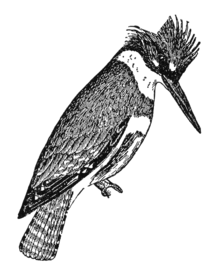King′fisher, a well-known fishing-bird of world-wide distribution. It is more common in the Old World than in the New. Of the 180 known kinds, only eight are inhabitants of the New World and only one is found in the Eastern United States. This bird — the common belted kingfisher — is widely distributed, but is a familiar bird only where fishing is to be had. There it is a common summer resident, comes early, as soon as the ice has broken up, and stays late, sometimes all winter. It is a beautiful bird, but less brilliant than other members of the group. The upper parts are bluish-gray and the under parts whitish, with a bluish-gray belt on the breast, the bird being considerably larger than the robin. The head is cresced, the bill long and dagger-like. It is a rapid flyer, but is sometimes seen perched on a post or dead tree near ponds and quiet rivers. It catches fish with dexterity in its strong bill. The kingfishers make nests in holes in the banks, and return year after year to the same place. There are numerous species of these birds, especially in the East Indies. The true kingfishers are closely related to the halcyons or wood kingfishers, famous in classical literature. There was an old fable to the effect that their nests floated on the water, and they were supposed to breed during the halcyon days — a period of 14 days — seven days preceding and seven days following the shortest day of the year. During these days, according to the old superstition, calm weather prevailed on the seas. See Blanchan: Bird Neighbors.
 |
 |